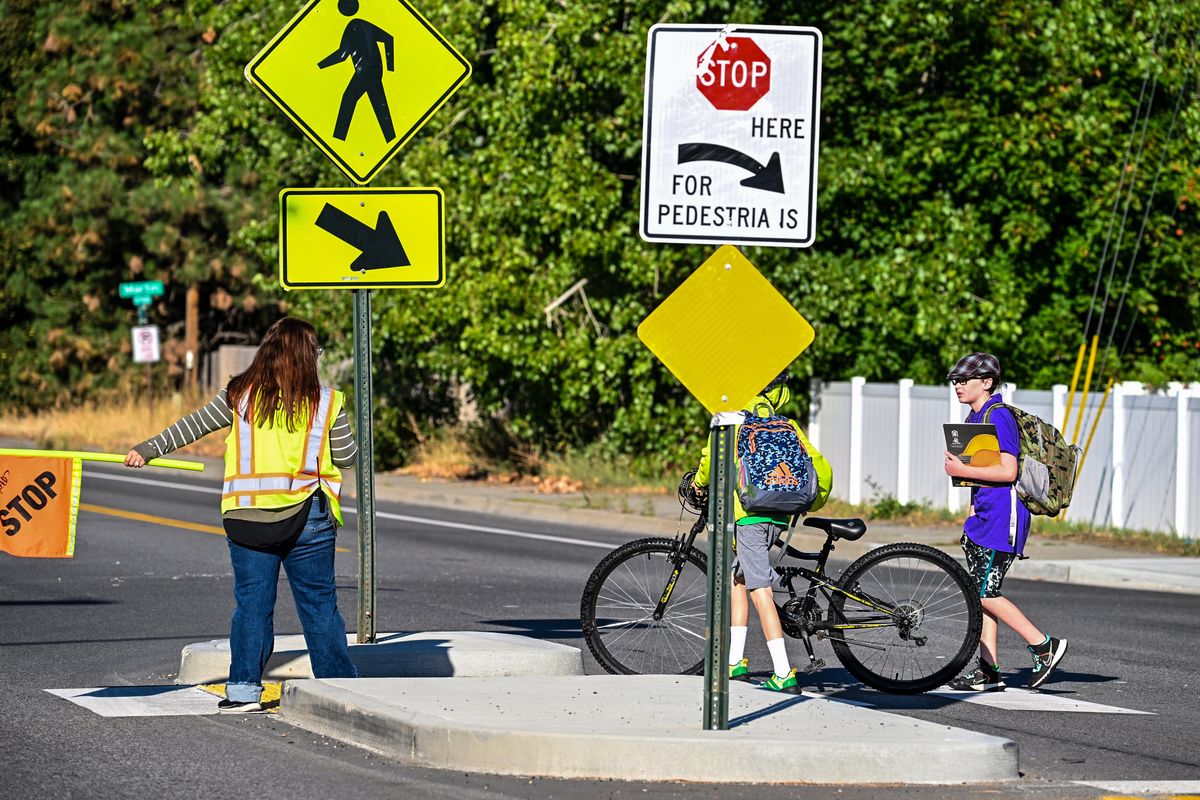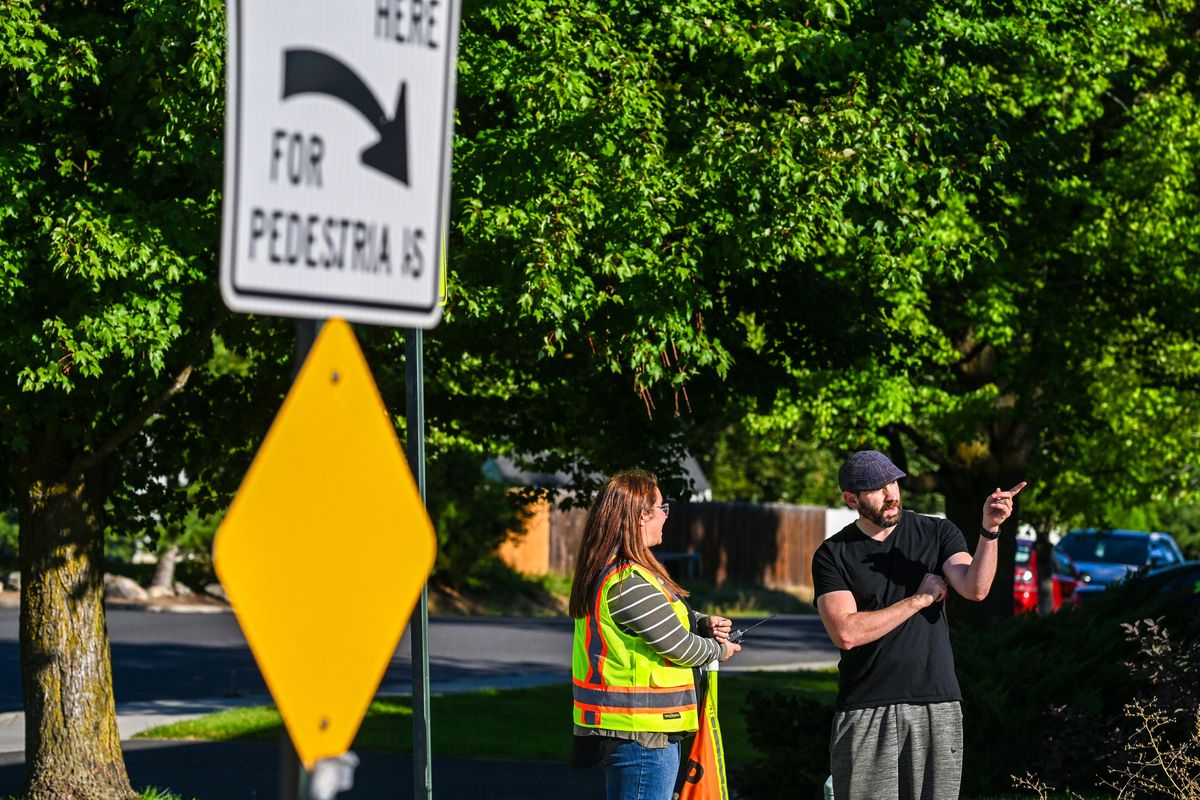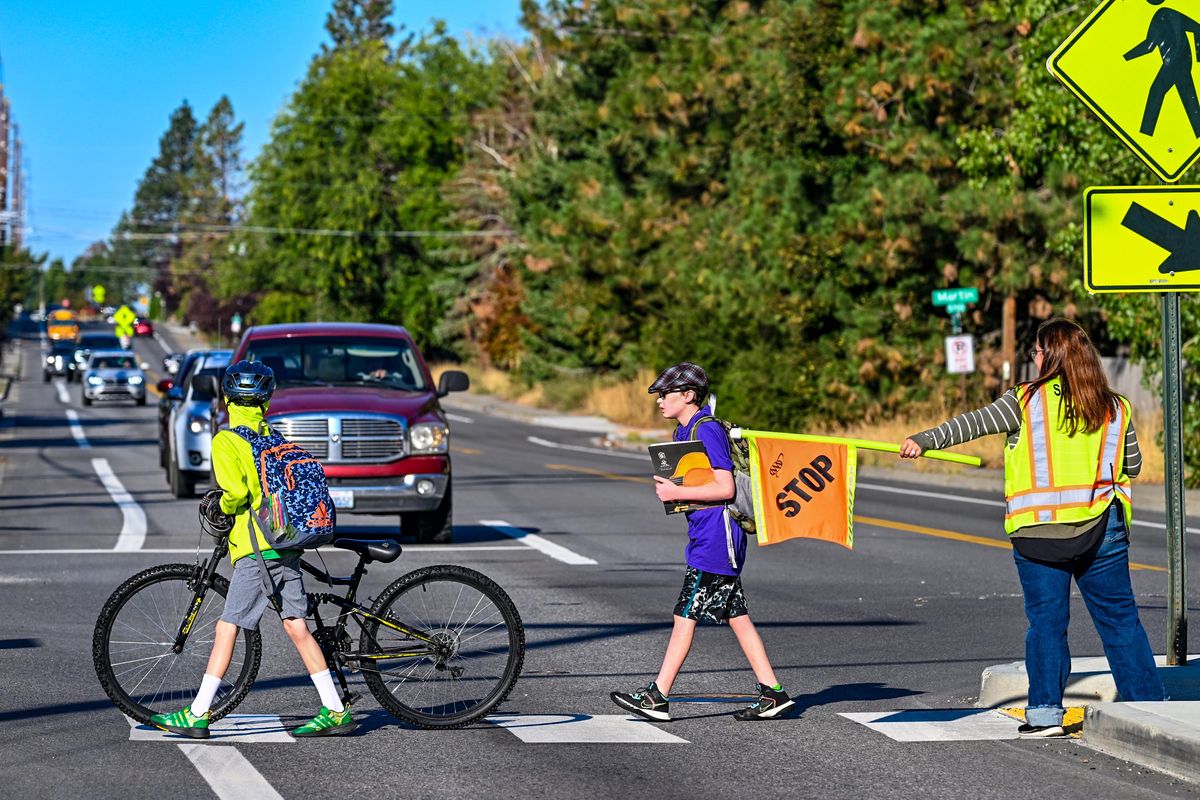Spokane Public Schools parents say new bus boundaries force students into long and potentially unsafe trek to class
Sixth grade student Cael Fitzgerald, center, crosses 57th Avenue at Crestline Street with help from Peperzak Middle School Assistant Principal Cori Fletcher, right, on Wednesday morning in Spokane. (DAN PELLE/THE SPOKESMAN-REVIEW)Buy a print of this photo
While they don’t have to walk many miles uphill both ways through a blizzard, some Spokane Public Schools parents are concerned about their students’ long and potentially hazardous trek to school.
Sixth graders’ integration into middle school on the south side of the district this year means 11-year-olds are now subject to the district’s middle school busing requirements that deny ridership to those residing within 1.5 miles as the crow flies of their school, with some exceptions. Parents at Peperzak Middle School said that boundary is unequitable, and in reality some kids are walking more than 2 miles.
Parents cite safety concerns over their kids’ march to school, portions of which lack sidewalks or lights at crossings. An online petition for accommodations started by Peperzak parent Brittany Fitzgerald has over 260 signatures. Fitzgerald wants to see district-wide action, not just for her sixth grader, but she said short staffing means the district doesn’t have much flexibility in acquiescing to parents’ complaints.
“Even if he gets a seat on the bus, are we solving the problem for any of the rest of the students who are not getting on the bus?” Fitzgerald said. “What about a crossing guard? What about a (school zone) speed limit sign? What about the flashing lights that cause people to have to stop in the crosswalk?”
The district is in the process of evaluating how they can return to the historic 1-mile radius wherein more students are eligible, Superintendent Adam Swinyard said at an Aug. 23 school board meeting. They don’t have a timeline, but it would take major district-wide reconfiguration of routes, according to Corey Arkle, district transportation manager. The district buses around 6,000 kids.
The intersection of 57th Avenue and Crestline Street is the crux of Fitzgerald’s frustration. The four-lane street’s crossing lacks all but one of the aforementioned features, and cars traveling well over the 35 mph speed limit are not uncommon, parents said. Last week, a parent reported a close call at this intersection to Peperzak administration, said Assistant Principal Cori Fletcher.
Unable to stomach the thought of her students at risk, Fletcher donned a neon yellow vest and was on the corner Monday morning, escorting students through the crosswalk.
“I wouldn’t want my babies crossing this street, so I want to make sure everybody else’s babies are safe,” Fletcher said before ushering three tiny cyclists across 57th.
In one morning, Fletcher chaperoned 20 kids across the street. After school is much busier, she said, in terms of student and car traffic. She said she sees unsafe driving daily; speeders, distracted drivers, those who don’t stop immediately at the crosswalk.
The school is in the finalization process of hiring a permanent crossing guard, and Fletcher said she’ll assume the role until they’re ready to receive the bright orange flag.
“This trumps all the other emails and phone calls and meetings that I have to take care of, because I can’t focus on those if I know our kids are not safe,” Fletcher said.
District administration requested the county install flashing lights at the crossing.
Fitzgerald’s son’s walk is closer to 1.8 miles and takes him about an hour. He’s not looking forward to the trek, which will get much heavier in the near future, “because I’m going to be carrying a bass,” he said.
His dad, Chris Fitzgerald, had the string instrument on his mind as he put his son’s camo backpack on him and sent him across 57th.
“Making sure all the school-issued stuff is protected and safe from the elements, that’s my main concern,” Chris Fitzgerald said. “Because I don’t want to have to buy additional equipment because he had to walk to school in the rain and he has to go and carry his laptop, large instrument, class projects.”
While Cael Fitzgerald braces himself to tote the instrument that’s taller than him, other walkers decide to forgo music for a lighter load, like Carlos Castillo-Garsow’s sixth grader at Peperzak.
“It’s an equity issue,” Castillo-Garsow said. “If you have students who have to walk 2 miles to school, 4 miles a day, carrying a heavy instrument isn’t going to be feasible and those students are going to miss out on opportunities.”
Castillo-Garsow clocks his son’s walk at 2.1 miles; when avoiding hazardous crossings, it takes him about an hour.
“A hour of his day is a lot to ask; that’s longer than my commute to Cheney,” he said.
Though September has brought warm temperatures and sunny days in Spokane so far, parents, students and the district know that winter is coming. Brittany Fitzgerald looks ahead to the dark afternoons when the sun sets around 4 p.m. in December. Middle school gets out at 3:30 p.m., so Cael could be walking at dusk.
Wintertime hazards mount when Brittany Fitzgerald considered berms of snow sure to accumulate on sidewalks as streets are plowed. Compact snow and ice can be slippery, and hazardous driving conditions mean hazardous pedestrian conditions.
Coming out of the pandemic, the district’s roster fell from 170 to 80 drivers, leading them to draw new standards for qualifying students for ridership based on proximity to the school. In 2021, the school board approved expanding the walk radius for middle schoolers from 1 mile to 1.5. The next school year, sixth graders on the north side of the district joined the ranks of middle schoolers, and many parents became concerned as their 11-year-olds were making the commute on foot. This year, when southside sixth graders integrated into middle school and the 1.5 mile walk radius, many of their parents joined the chorus calling for change.
The district employs 140 bus drivers through contractor Zum, with more already hired and in the queue to be trained.
“If we went back, how many more eligible riders would we have? How many more buses would we need? And we’re at a level right now where we have coverage for what we’re serving, but we don’t have a surplus,” Arkle said. “So before we commit more service to more families, we have to make sure that we can actually provide it.”
It would require a change to all existing routes, Arkle said, with major financial implications for the district.
As of this week, the district has already seen 1,000 late registrations for busing, another factor Arkle said they must consider when planning bus routes and evaluating accommodations.
The district has received seven requests for accommodations from students residing in the walk radius and fulfilled five of them. The district considers requests based on the order they’re received and how easy it would be to accommodate the student, weighing factors like nearby bus stops, route capacity, and the time the route takes, Arkle said.
Editor’s note: This story has been with the correct spelling of Carlos Castillo-Garsow’s name.


